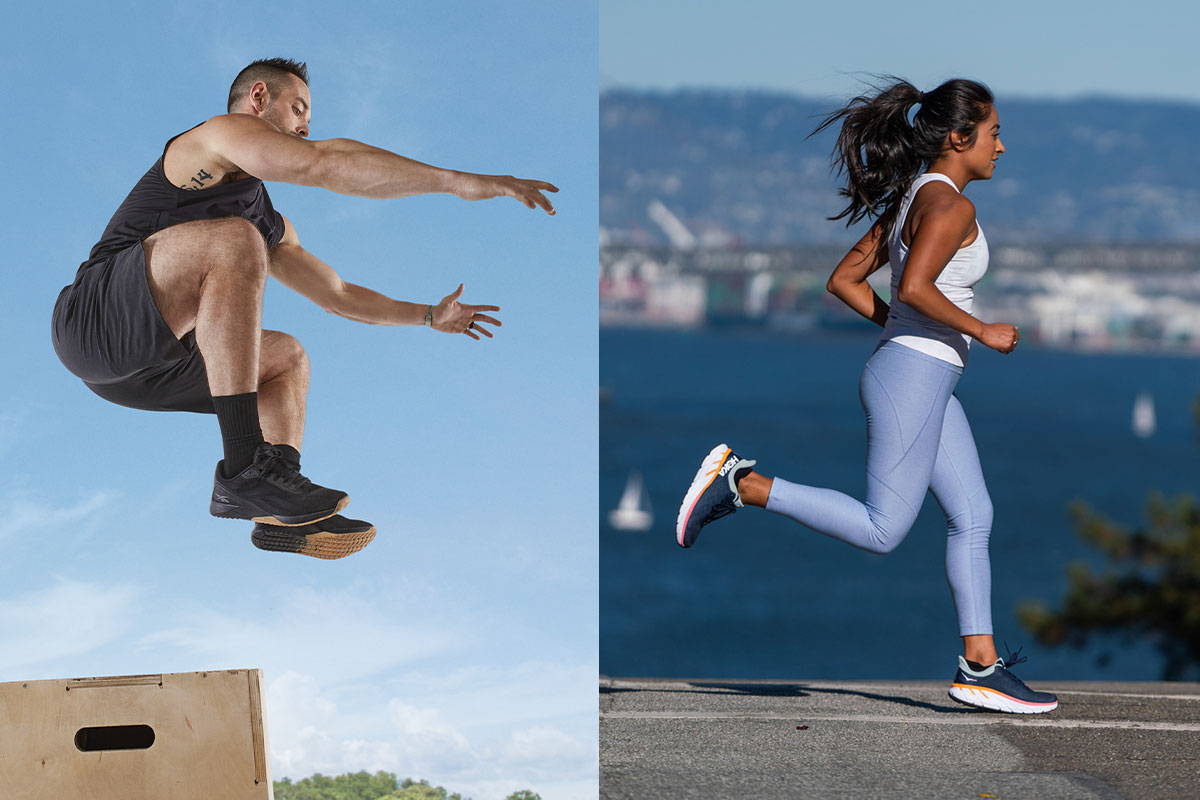When it's time to exercise, one of the most important yet overlooked decisions you make lies at your feet. Choosing the right shoes for your activity can be the difference between crushing your goals or coming up short. Whether you’re training for a 5K, taking an exercise class, or lifting heavy weights in the gym, having the proper footwear can take your training to another level.
In general, there are two main types of athletic shoes: running and cross-training. The biggest difference is in the design.
Running shoes are made to help you go one way – forward. These shoes typically have more cushion in the heel and forefoot to absorb the impact from every step you take. They also provide energy return to propel you forward during your runs.
Differences In Design
On the flip side, cross-training shoes offer more lateral stability. Think of exercises like agility drills, CrossFit workouts, high interval training, or heavy lifting.
Cross-training shoes have a lower heel-to-toe drop, better grip, and a stable heel for support. This construction comes in handy during powerful movements like squats, deadlifts, cleans and presses.
There are many differences between running and cross training, including flexibility, durability, and cushioning.
Flexibility
Cross-training shoes have a more flexible sole for dynamic movement. Running shoes are designed to go in one direction, while cross-training workouts require more lateral (side-to-side) movements.
Durability
Cross-training shoes use a more durable upper to protect against abrasion during high-intensity training. The upper in running shoes is more breathable to allow for ventilation and keep your feet cool.
Cushion
Cross-training shoes add more cushioning in the forefoot to absorb the impact from landing on your toes. While running shoes have forefoot cushion, they also have padding in the heel to support any foot strike.
It should be no surprise that running in cross-training shoes or lifting in running shoes is NOT a good idea. But more on that later.
Frequently Asked Questions
Can I wear running shoes to the gym?
Here comes everyone’s favorite answer: it depends.
If you’re sticking to the machines and using free weights, there’s nothing wrong with using a running shoe. But for heavy lifting and high-intensity workouts, you need a shoe with a lower drop and more stable platform to truly maximize your potential.
If you’re taking fitness classes that require fast and frequent side-to-side movements, a running shoe will feel sluggish and not as supportive.
Can I run in cross-training shoes?
While new technologies in cross-training shoes make this more possible than before, we still wouldn’t recommend it for long-distance running. Shoes like the Reebok Nano and On Cloud X can support sprinting, but if you’re planning for high mileages, stick to a running shoe.
Most cross-training shoes are heavier than running shoes, so they’ll weigh you down without providing the cushioning and support you need to reach your goals. If your aim is to enjoy these activities, then rocking the right pair of shoes is the first step to ensure success.
Think of it this way: would you rather spend extra cash on shoes that will protect you during exercise or pay medical expenses because you suffered an injury by going the cheap route?
What shoes should I wear for my activity?
Let’s play a game! We’ll start with four imaginary athletes who’ll describe their daily workout routine. Based on their activities, we’ll either recommend a cross-training shoe or a running shoe. These examples should give you a clear idea about which pair to pick for your next workout. You'll find the answers at the end of this quiz.
1. “I enjoy running outside three to five times a week, with a weekly mileage total anywhere between 10-50 miles. I like varying my workouts, from tempo training to long distances. What shoes should I use?”
2. “I like lifting heavy weights in the gym. Most of my time is spent on the mat doing squats, deadlifts, cleans and presses. I’m looking for a shoe that will help me set PRs in the weight room. What shoes should I use?”
3. “I’m going to the gym to do a mix of weights and cardio. I like to use machines and dumbbells for my workouts. After that, I’ll run on the treadmill for 30 minutes to an hour. What shoes should I use?”
4. “I’m all about high-intensity training. Whether it’s quick, short bursts like sprints or explosive lifts, I enjoy the rush from hard efforts. I never know what the daily workout will demand, so I need to stay on my toes and ready for anything. What shoes should I use?”
Answers
1. Running Shoes
2. Cross Training Shoes
3. Running Shoes
4. Cross Training Shoes
Now that you know the difference between running and cross-training shoes, you’re ready to purchase the right pair for your activity!
Picking the Right Pair
For whatever you choose, Holabird Sports is here to help you make the right decision. For over three decades, we've supported our customers’ search for the perfect pair. You can count on trained professionals with extensive product knowledge to answer any questions and concerns you may have. Your health and success are our main priorities.
Think of us as your gentle guide on this fitness journey – here to celebrate every small victory or huge accomplishment each step of the way.
Time for an upgrade? Check out our selection of running shoes and our selection of training shoes!

